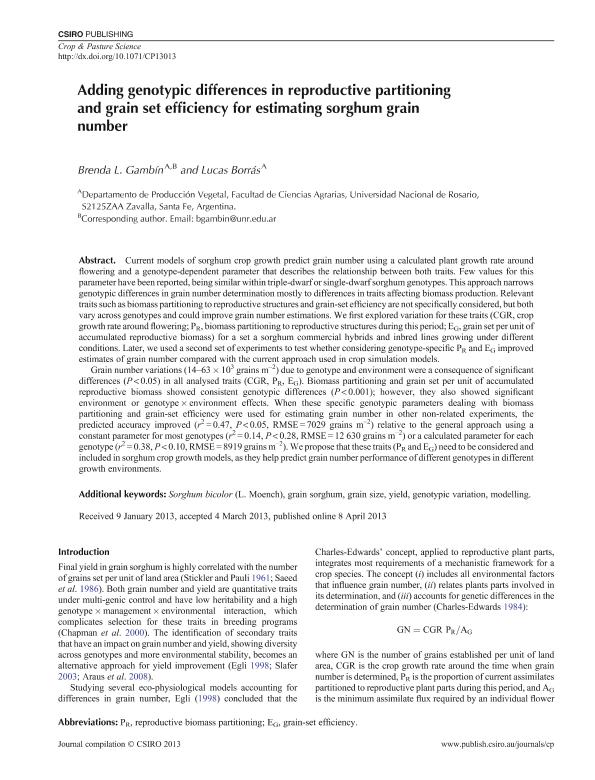Artículo
Adding genotypic differences in reproductive partitioning and grain set efficiency for estimating sorghum grain number
Fecha de publicación:
04/2013
Editorial:
Csiro Publishing
Revista:
Crop and Pasture Science
ISSN:
1836-0947
Idioma:
Inglés
Tipo de recurso:
Artículo publicado
Clasificación temática:
Resumen
Current models of sorghum crop growth predict grain number using a calculated plant growth rate around flowering and a genotype-dependent parameter that describes the relationship between both traits. Few values for this parameter have been reported, being similar within triple-dwarf or single-dwarf sorghum genotypes. This approach narrows genotypic differences in grain number determination mostly to differences in traits affecting biomass production. Relevant traits such as biomass partitioning to reproductive structures and grain-set efficiency are not specifically considered, but both vary across genotypes and could improve grain number estimations. We first explored variation for these traits (CGR, crop growth rate around flowering; PR, biomass partitioning to reproductive structures during this period; EG, grain set per unit of accumulated reproductive biomass) for a set a sorghum commercial hybrids and inbred lines growing under different conditions. Later, we used a second set of experiments to test whether considering genotype-specific PR and EG improved estimates of grain number compared with the current approach used in crop simulation models. Grain number variations (14–63 103 grains m–2 ) due to genotype and environment were a consequence of significant differences (P < 0.05) in all analysed traits (CGR, PR, EG). Biomass partitioning and grain set per unit of accumulated reproductive biomass showed consistent genotypic differences (P < 0.001); however, they also showed significant environment or genotype environment effects. When these specific genotypic parameters dealing with biomass partitioning and grain-set efficiency were used for estimating grain number in other non-related experiments, the predicted accuracy improved (r 2 = 0.47, P < 0.05, RMSE = 7029 grains m–2 ) relative to the general approach using a constant parameter for most genotypes (r 2 = 0.14, P < 0.28, RMSE = 12 630 grains m–2 ) or a calculated parameter for each genotype (r 2 = 0.38, P < 0.10, RMSE = 8919 grains m–2 ). We propose that these traits (PR and EG) need to be considered and included in sorghum crop growth models, as they help predict grain number performance of different genotypes in different growth environments.
Palabras clave:
Sorghum
,
Grain Number
,
Grain Size
,
Modelling
Archivos asociados
Licencia
Identificadores
Colecciones
Articulos(CCT - ROSARIO)
Articulos de CTRO.CIENTIFICO TECNOL.CONICET - ROSARIO
Articulos de CTRO.CIENTIFICO TECNOL.CONICET - ROSARIO
Citación
Gambin, Brenda Laura; Borras, Lucas; Adding genotypic differences in reproductive partitioning and grain set efficiency for estimating sorghum grain number; Csiro Publishing; Crop and Pasture Science; 64; 1; 4-2013; 9-17
Compartir
Altmétricas




